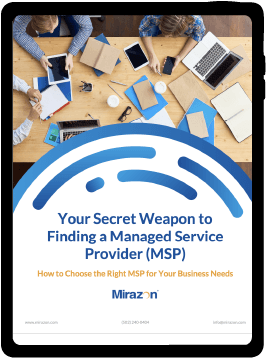Reach Out – We're Listening!
Have questions or need assistance? Drop us a line – we can’t wait to meet you.
Headquartered in Louisville, Kentucky, we proudly deliver world-class IT support and solutions to customers across the nation.
Proudly based in Louisville, Kentucky and serving customers nationwide, Mirazon has a diverse team of experienced technicians to help augment your existing team. If you’ve got a great server crew, but don’t have time to manage your firewalls or network devices, we can do that! Or, if you’ve got almost all of it covered, but need help supporting your end users, we’re there. Choose the right managed services that fit your needs and budget.
Patching, alerting, monitoring, and maintenance on your critical business networks to keep you connected 24/7.
24/7 monitoring, alerting, and management of the critical systems your organization relies on: servers, network, storage, backups.
Helpdesk services, email support, server support, cloud services, or cybersecurity management – and everything that’s in between – we are your IT folks.

Download our
Free MSP Guide!

"*" indicates required fields
Our Managed IT Services are designed to provide your business with a significant competitive advantage through tailored IT solutions. Our team of IT experts are trained and equipped to manage, protect, and maintain your IT infrastructure proactively – because we understand that it can be complex and difficult to manage. That’s why we offer comprehensive managed IT services solutions that ensure your IT environment is both secure and responsive. By optimizing systems to meet your organization’s unique needs, we will help you save money, increase efficiency, and improve productivity.
We partner with industry leaders like Microsoft and Fortinet to secure your infrastructure and provide expert support for your growing business.
Co‑Managed IT
Partner with your internal IT team to get expert backup with EDR monitoring, patching, access control, helpdesk support, and backup oversight.
Standard
All-in IT support: 24/7 monitoring, patching, backups, helpdesk, and user/server management and strategic business reviews.
Enhanced Security
Everything in Standard, plus enterprise-grade protection: SIEM, 24/7 SOC, vulnerability scanning, and staff security training.

Got more questions? Get clear answers to your IT needs!
Signs you need managed IT services:
If technology is working against you instead of for you, Mirazon’s managed IT services can help transform your IT from a burden into a business advantage.
Core Specializations:
Managed IT services provide proactive, outsourced technology management including:
Key Benefits:
Smart IT spending means:
Mirazon’s proactive approach helps safeguard your brand reputation from technology issues while enhancing customer service to support your business growth. Our goal is to help you make smart investments now to prevent costly problems in the future.
Simply put, outsourcing projects or all your needs, Mirazon worries about the technology, so you don’t have too.